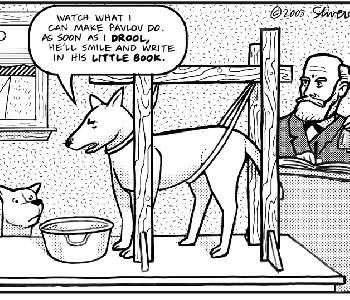Sadržaj
Classical conditioning
General
Classical conditioning (sometimes also known as Pavlov conditioning, respondent conditioning or Pavlovian reinforcement) is an behaviorist learning theory introduced in the first decade of the 20th century by the Russian physiologist Ivan Pavlov.
What is classical conditioning?
Classical conditioning is based on the famous Pavlov's dogs experiment. He first performed a minor operation on the dog enabling easier measuring of salivation. The dog was then trained by ringing a big bell every time after it was served food. Soon, the dog associated the sound of the bell with food, that caused the reflex of salivating. In this experiment, Pavlov, with means of reinforcement, thought his dog to respond to the sound of the bell (conditioned stimulus, CS) by salivating (in this case both conditioned and unconditioned response, CS, UCS), which is the same way they would respond to food (unconditioned stimulus, US)1).
The learning process here consists of associating an environmental (conditioned) stimulus to a naturally occurring (unconditioned) stimulus. During the learning process it is important that unconditioned stimulus appears before conditioned stimulus. Successful learning is manifested in a natural reflex reaction on an associated environmental stimulus.2) This two statements define the classical conditioning.
Other important parameters of classical conditioning, introduced and researched by John Watson, another founder of behaviorism are3):
- latency - length of time interval between unconditioned and conditioned stimulus,
- extinction - decreasing of the probability of learned behavior after unconditioned and conditioned stimulus appeared impaired for a number of times, and
- spontaneous recovery - spontaneous re-occurrence of learned behavior after extinction.
Another two examples of classical conditioning are taste aversion (for example after a negative experience with alcohol) and the little Albert experiment by Watson.
In the little Albert experiment he showed how an emotional response can be learned or conditioned which was a very new concept at the time. He let a 11 months old child nicknamed Albert B. play with a white rat. Still, every time Albert would try to reach for it, a loud noise was produced initializing fear in him. After a few trials, Albert would cry at the mere sight of the rat. Further experiments showed he was scared even of rabbits, dogs, fur coats or Santa Claus mask. A detailed information about the experiment can be found here. The little Albert experiment had a great impact on psychology and other disciplines, yet it also raised a lot of controversies.4)
Basic behaviorist principles can also be recognized in this experiment: Watson approaches learning as to a visible change in behavior formed by external stimuli, and even in case of performing an experiment on a human subject, he ignores learners mind processes.
Watson was often cited for his claims understandable in context of behaviorism where environmental stimuli are critical for learning:
- Give me a dozen healthy infants, well-formed, and my own specified world to bring them up in and I'll guarantee to take any one at random and train him to become any type of specialist I might select – doctor, lawyer, artist, merchant-chief and, yes, even beggar-man and thief, regardless of his talents, penchants, tendencies, abilities, vocations, and race of his ancestors. I am going beyond my facts and I admit it, but so have the advocates of the contrary and they have been doing it for many thousands of years.5)
What is the practical meaning of classical conditioning?
Even apart from classical conditioning techniques that help people or professionals train their pets, in reality there are many real-world applications for classical conditioning. These applications often include the treatment of phobias or anxiety problems in educational process.
Teachers can apply classical conditioning methods by creating a positive atmosphere in the classroom in order to help students. By relating a situation that causes anxiety or nervousness, such as performing in front of an audience, with relaxed surroundings and supportive outcome, students learn new associations. Instead of feeling anxious in these situations, the student will learn to stay relaxed and calm.
Criticisms
Classical conditioning is experimentally confirmed and cannot be rejected as a learning theory, but its scope is limited and it ignores all cognitive aspects of learning, so it has lost most of its influence today, especially in context of educational psychology. Meaningful criticisms were also offered by gestalt psychologists who later inspired cognitivist ideas of explaining the human cognitive structure. Models of human cognitive structure developed in 1960s have suggested humans are capable of learning forms superior to stimulus-response learning.
Keywords and most important names
- Classical conditioning, Pavlov conditioning, respondent conditioning, Pavlovian reinforcement, Pavlov's dogs, little Albert, conditioned stimulus, conditioned response, unconditioned stimulus, unconditioned response, latency, extinction, spontaneous recovery
Bibliography
Cherry, Kendra. Introduction to Classical Conditioning. Retrieved January 5, 2011.
Classical Conditioning (Pavlov) at Learning Theories. Retrieved January 7, 2011.
Psychology World: Classical Conditioning. Retrieved January 7, 2011.
